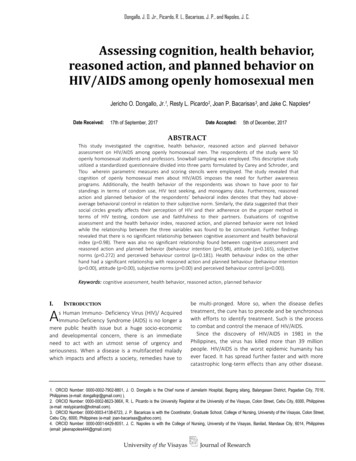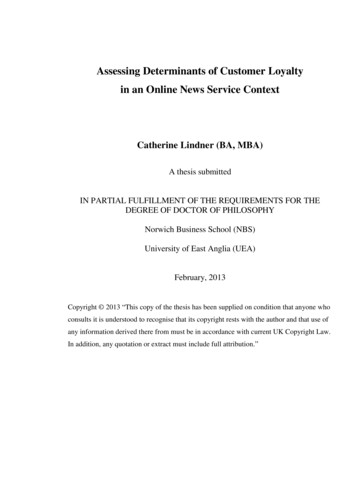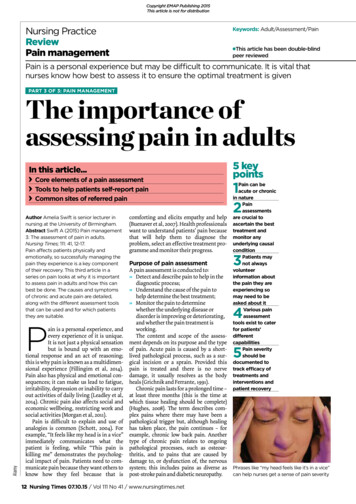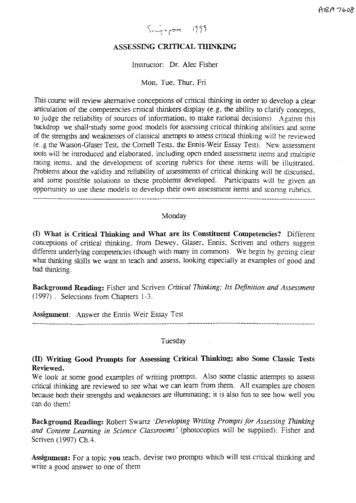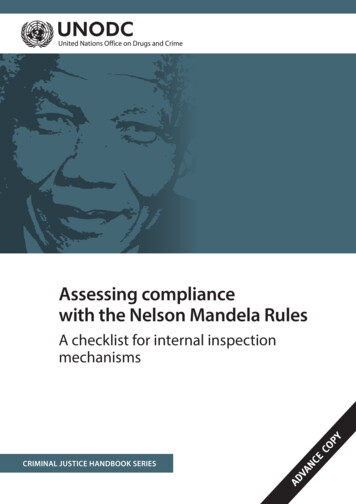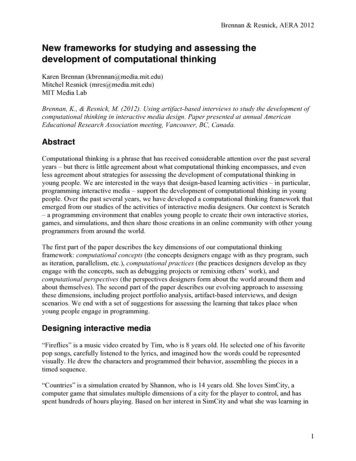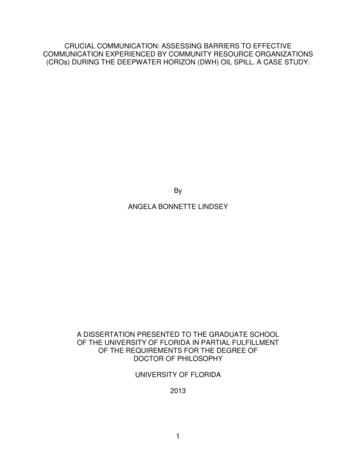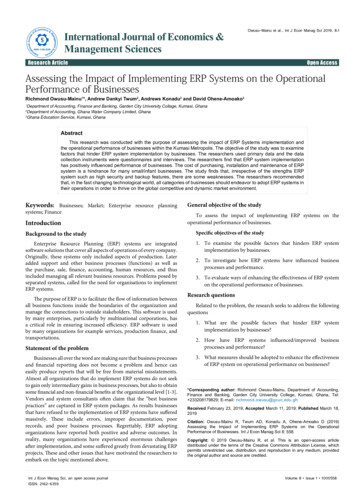
Transcription
International Journal of Economics &Management Sciencesagement ScaniMnal Journatiolnaonomics &EcofISSN: 2162-6359Owusu-Mainu et al., Int J Econ Manag Sci 2019, 8:1cesenInterResearch ArticleResearch ArticleOpen AccessOpen AccessAssessing the Impact of Implementing ERP Systems on the OperationalPerformance of BusinessesRichmond Owusu-Mainu1*, Andrew Dankyi Twum2, Andrews Konadu3 and David Ohene-Amoako3Department of Accounting, Finance and Banking, Garden City University Collage, Kumasi, GhanaDepartment of Accounting, Ghana Water Company Limited, Ghana3Ghana Education Service, Kumasi, Ghana12AbstractThis research was conducted with the purpose of assessing the impact of ERP Systems implementation andthe operational performance of businesses within the Kumasi Metropolis. The objective of the study was to examinefactors that hinder ERP system implementation by businesses. The researchers used primary data and the datacollection instruments were questionnaires and interviews. The researchers find that ERP system implementationhas positively influenced performance of businesses. The cost of purchasing, installation and maintenance of ERPsystem is a hindrance for many small/infant businesses. The study finds that, irrespective of the strengths ERPsystem such as high security and backup features, there are some weaknesses. The researchers recommendedthat, in the fast changing technological world, all categories of businesses should endeavor to adopt ERP systems intheir operations in order to thrive on the global competitive and dynamic market environment.Keywords: Businesses; Market; Enterprise resource planningsystems; FinanceIntroductionGeneral objective of the studyTo assess the impact of implementing ERP systems on theoperational performance of businesses.Background to the studySpecific objectives of the studyEnterprise Resource Planning (ERP) systems are integratedsoftware solutions that cover all aspects of operations of every company.Originally, these systems only included aspects of production. Lateradded support and other business processes (functions) as well asthe purchase, sale, finance, accounting, human resources, and thusincluded managing all relevant business resources. Problems posed byseparated systems, called for the need for organisations to implementERP systems.1. To examine the possible factors that hinders ERP systemimplementation by businesses.The purpose of ERP is to facilitate the flow of information betweenall business functions inside the boundaries of the organization andmanage the connections to outside stakeholders. This software is usedby many enterprises, particularly by multinational corporations, hasa critical role in ensuring increased efficiency. ERP software is usedby many organizations for example services, production finance, andtransportations.Statement of the problemBusinesses all over the word are making sure that business processesand financial reporting does not become a problem and hence caneasily produce reports that will be free from material misstatements.Almost all organizations that do implement ERP systems do not seekto gain only intermediary gains in business processes, but also to obtainsome financial and non-financial benefits at the organizational level [1-3].Vendors and system consultants often claim that the “best businesspractices” are captured in ERP system packages. As results businessesthat have refused to the implementation of ERP systems have sufferedmassively. These include errors, improper documentation, poorrecords, and poor business processes. Regrettably, ERP adoptingorganizations have reported both positive and adverse outcomes. Inreality, many organizations have experienced enormous challengesafter implementation, and some suffered greatly from devastating ERPprojects. These and other issues that have motivated the researchers toembark on the topic mentioned above.Int J Econ Manag Sci, an open access journalISSN: 2162-63592. To investigate how ERP systems have influenced businessprocesses and performance.3. To evaluate ways of enhancing the effectiveness of ERP systemon the operational performance of businesses.Research questionsRelated to the problem, the research seeks to address the followingquestions1. What are the possible factors that hinder ERP systemimplementation by businesses?2. How have ERP systems influenced/improved businessprocesses and performance?3. What measures should be adopted to enhance the effectivenessof ERP system on operational performance on businesses?*Corresponding author: Richmond Owusu-Mainu, Department of Accounting,Finance and Banking, Garden City University College, Kumasi, Ghana, Tel: 233208179829; E-mail: richmond.owusu@gcuc.edu.ghReceived February 23, 2019; Accepted March 11, 2019; Published March 18,2019Citation: Owusu-Mainu R, Twum AD, Konadu A, Ohene-Amoako D (2019)Assessing the Impact of Implementing ERP Systems on the OperationalPerformance of Businesses. Int J Econ Manag Sci 8: 558.Copyright: 2019 Owusu-Mainu R, et al. This is an open-access articledistributed under the terms of the Creative Commons Attribution License, whichpermits unrestricted use, distribution, and reproduction in any medium, providedthe original author and source are credited.Volume 8 Issue 1 1000558
Citation: Owusu-Mainu R, Twum AD, Konadu A, Ohene-Amoako D (2019) Assessing the Impact of Implementing ERP Systems on the OperationalPerformance of Businesses. Int J Econ Manag Sci 8: 558.Page 2 of 10Significance of the studyThe significance of the study is to get a deep view about the impact ofERP system on the operational performance of businesses. Then at theend of the work readers would find that whether the implementationcan save money, time and reduce extra work? Whether the investmentin ERPs is worthwhile? These questions are linked to one key issue,does this system increase the company’s operational performance?Limitation of the studyThe study focuses on private organizations in the centralbusiness district of (Adum) Kumasi. In Ghana ERP adoption andimplementation is more prevalent in private entities than in publicones, a fact attributable to meet the need for private firms to focus moreon the efficient management of their limited and scarce resources. Mostof the organizations were not happy due to the fact that after knowingmuch about what they do, the researchers may leak some confidentialinformation. So they were reluctant to give us information. Withpersistent request all that we need were given and that helped theresearchers to complete the work on time.Literature ReviewIntroductionThis chapter reviews existing literature and establishes gaps withregard to studies on ERP implementation benefits and impact onorganizational operational performance.Evolution and definitions of ERPThe term Enterprise Resource Planning (ERP) was developedfrom the evolution and expansion of Material Requirements Planning(MRP) and Manufacturing Resource Planning (MRP II) to includemore business functions and processes. In the 1980’s MRP expandedfrom a material planning and control system to a firm-wide systemwith the capabilities for the planning and control of almost all the firm’sresources [4]. Differences in definitions have developed because ERPstudies have emerged from diverse areas of studies, leading to differentapplications by practitioners and academics. Some researchers lookedat ERP as both a concept and a system [5]. Conceptually, ERP is seenas the integration of various business processes in an organizationleading to a better order management and control, accurate inventorymanagement information, better workflow and supply chainmanagement and improved industry best practices.This line of thinking was also employed and defined, ERP systemas an amalgamated software package, which combines a set of standardfunctional modules (Production, Sales, Human Resources, Finance,etc), developed or put together by an organization, and which couldbe used for the specific needs of each customer. The integration andcoordination also creates new visibility or greatly improves existingvisibility across and beyond the structures and processes of theorganization.Varied ERP studies in developed and developing nationsERP implementation in developing countries leads to a differentexperience compared to implementation in developed countries [6].In this section, we explore the context of developing and developedcountries and consider research on ERP implementation within thesetwo contexts.The World Bank uses gross national income (GNI) as the metricInt J Econ Manag Sci, an open access journalISSN: 2162-6359for classifying economies. Under its classification module, economieswith per capita income below 13,460 are categorized as non-highincome countries with some 72% of the world population falling underthis group as at 2012 [7].Factors that hinders the implementation of ERP system: Addedto the wide disparity in IT related research between developed anddeveloping countries, few researchers have specifically focused on ERPimplementation, adoption and assimilation. Compared the variousimplementation practices of ERP between developed and developingcountries and noted that developing countries are confronted withsome key unique challenges: economic, cultural and infrastructure.They concluded that ERP implementation has a positive impact ongaining competitive advantages for organizations with advancednational and organizational factors. Although some researchers lookat these factors as impediments to successful ERP implementationin developing countries, others look at them as specific and uniquefactors that must be taken into consideration before ERP projects areundertaken.Some of these factors are examined as control variables in thisstudy. Kouki et al. [8] investigated factors that will stimulate successfulERP assimilation and the differences in impact between developed anddeveloping countries. Other factors they identified included trainingand education, IT support, organizational culture, managers anduser involvement, and finally strategic alignment. According to theauthors, developing countries’ main problem- high power distance,also presents its own peculiar issues with IT (Information technology)and ERP assimilation.ERP, just like all other information systems, is implementedwithin various cultural contexts of the individual, organisation andsociety. When ERP is adopted and assimilated within these diverse anddynamic contexts, conflicts are inevitable. The management of theseevolving cultures is important. Awareness of cultural differences istherefore key to ERP success; managers should consider evaluating thechances of cultural conflicts when embarking on IT facility changes.The study further asserts that implementation of IT alone does notsolve all problems within an organisation and the possibility of ethicalissues surrounding managerial cultural change was also highlighted.The influence of ERP system on business processes: Conductingbusiness in developing countries tend to be more frustrating thandeveloped countries. Low per capita income and general poverty, forinstance, mean companies must offer their products at lower unitprices, or make them smaller, or of lesser quality. Poor infrastructureand little capital also mean that it is more difficult for local businessesto emerge and survive.They also noted that institutional pressures contribute to postimplementation assimilation when the integration processes areprolonged and outcomes are dynamic and uncertain.The effectiveness of ERP system on the operational performanceof businesses: The impact and effect of IT implementation onorganizations has been more exhaustively studied. The relationbetween IT and firm performance can be categorized into 3 paths; path1- is a direct relationship between IT and Overall firm performance;Path 2- focuses on the relationship between IT and business processperformance; and Path 3 looks at how the processes interact toinfluence the overall firm performance. They suggested that a fourthpath, which looked at the other contextual factors that influence therelationship between business process and overall firm performanceVolume 8 Issue 1 1000558
Citation: Owusu-Mainu R, Twum AD, Konadu A, Ohene-Amoako D (2019) Assessing the Impact of Implementing ERP Systems on the OperationalPerformance of Businesses. Int J Econ Manag Sci 8: 558.Page 3 of 10(size, IT intensity, financial health, industry) could be considered.Further investigations into these paths and examined the validity oftwo commonly used measures of success of information systems. Heconcluded that user satisfaction is significantly related to performance.However the relationship between usage and performance was not assignificant. He also observed that a partial correlation after correctionfor user satisfaction was not significant either.Research into ERP implementations reveals that the impact of ERPon performance may not always be positive.ERP systems implementation is not an inexpensive or risk-freeventure. According to Seethamraju and Seethamraju up to 65% ofexecutives sampled believed that ERP systems have at least a moderatechance of hurting their businesses because of potential implementationproblems [9]. It is thus worthwhile to examine factors that determinewhether the implementation will be successful or not as part of ERPimpact studies.Profile of Kumasi metropolisKumasi Metropolitan is one of the twenty-seven districts in theAshanti region. The Metropolitawas established on 10th March, 1989 bya legislative instrument (LI) 1473.This was the period Ghana adoptedthe District Assembly concept. The overall goal is to accelerate growthand development in the Metropolitan. The Kumasi west district wascarved from this Metropolitan on November 2007.The economy of the Metropolitan used to be predominantlyagrarian. However, the upsurge of commercial, industrial and serviceactivities depicts potential diversification of the local economy.Currently the service sector employs majority (58.3%) of the populationin the Metropolitan.The Metropolitan has a number of educational facilities. Underthe public sector, it has 111 basic schools, 50 junior high schools, fivesenior high/vocational and two tertiary. The private sector on the otherhand has 117 basic schools, 37 junior high school and fours seniorhigh/vocational schools.There are quite a number of financial institutions that are foundin the Metropolitan. These comprise banks and non-bank financialinstitutions such as micro finance companies. Notable among thebanks and non- financial institutions in the Metropolitan area;Ghana Commercial Bank, Barclays Bank, Zenith Bank, Ecobank, StarAssurance, Vanguard Insurance, Excel Microfinance, First AlliedSavings and Loans, Multi Credit Savings and loans, OpportunitySavings and Loans, etc. These financial institutions help in improvingthe living conditions of the inhabitants in the Metropolitan by grantingloans to desired customers and also aiding in investments.Six hospitals, twelve clinics, seven chips compound, threematernity homes and three (3) health centers provide health services tothe district population of 123,224 (2010 PHC).These businesses are a source of livelihood for a number of theinhabitants. The introduction of pharmaceutical companies such asErnest Chemist and Kama Health Service Limited in the Metropolitanhas also improved the economy of the Metropolitan. Most of thesecompanies are relocating some of their branches to the Metropolitan toserve as a distribution centre to other parts of the region.Livestock production is becoming one of the major potentials inthe Metropolitan. Some of the population engages in these productionseither on a subsistence base or on large scale. Some of the livestockInt J Econ Manag Sci, an open access journalISSN: 2162-6359produced includes: poultry, cattle, grass cutter, rabbits and manyothers.MethodologyIntroductionThis chapter presents the study area and the type of methodologyuse for the research for the study. The section also talks about the studypopulation and the sampling technique used by the researcher.Research designA case study approach was used in the study. This research designwas use because data was collected from a large population (50). Theresearcher used self- administered questionnaire and interview ingathering the data from the respondents. This method was chosen asit proved to be the most appropriate in terms of the time and resourcesto the researchers. It also afforded the opportunity to meet and relatewith the respondents.PopulationGiven the exploratory nature of the study, all organizations thathave implemented ERP systems in Kumasi were targeted with nodefinitive boundaries, type of ERP system implemented, or extent ofimplementationSource of dataThe researcher used primary sources of data.Sample size and sampling techniquesThe sample for the study was (50) respondents from (10) selectedorganizations in Kumasi. The sampling technique used was theconvenience non-probability sampling. This sampling techniqueis where a sample (subjects) is selected based on the researcher’sconvenience like availability of the subjects.Data collection instrumentThe research instrument used in this study comprised close endedand open ended questionnaire that was designed by the researchers.Data collection proceduresThe administration of the questionnaire helped the researchersto build report and also to explain the purpose of the study to therespondents. The unit of analysis was therefore the organization and thusthe CEOs of various organizations, senior IS executives, and selectedfunctional heads who use the systems were the most appropriate fordata source for this research. To the best of the researcher‘s knowledge,the estimated targeted firms that have implemented ERP systemsamounts to 10 distributors in Kumasi. For each target organization forthe main survey, at least one senior IS executive and one senior nonIS executive were targeted. For selected large organizations, functionalheads (Finance/Accounting, Operations, Information Technologyand Marketing) were additionally targeted. Hence, the number ofquestionnaires to be delivered to target organizations ranged froma minimum of three to a maximum of five based on the size of theorganization.Data analysis methodIn order to ensure simple interpretation and comprehension, thedata was mainly analyzed using descriptive tools, such as pie charts,Volume 8 Issue 1 1000558
Citation: Owusu-Mainu R, Twum AD, Konadu A, Ohene-Amoako D (2019) Assessing the Impact of Implementing ERP Systems on the OperationalPerformance of Businesses. Int J Econ Manag Sci 8: 558.Page 4 of 10bar chat, and summarily presented in tabular and graphical forms.Data was disaggregated and presented using tables and diagrams.Each research question was analyzed based on responses given by therespondents and converted to percentages.the ten (10) selected businesses within the Kumasi Metropolis whohad implemented ERP systems and the total number of questionnairesrepresenting 100%. Out of the total number of questionnairesdistributed and retrieved, twenty (20) were management staff(General Manager, Accountant) representing 40% and thirty (30) wereoperational staff (System Administrator, Wholesale/Stores Manager,Sales Person) representing 60%.Data validity and reliabilityIn order to validate the research instrument, the questionnaire waspiloted on a sample of some selected businesses in Kumasi. Samplesof the questionnaire were also submitted to the supervisor for hiscomments and the necessary corrections made. This was to checkwhether the questionnaire designed can answer the research questionsposed.Care was taken to ensure that all ten (10) businesses wererepresented in the chosen sample in order to make the sample asrepresentative of the population as possible.Analysis of demographic features of the respondentsEthical considerationTable 2 depicts tha
Enterprise Resource Planning (ERP) systems are integrated software solutions that cover all aspects of operations of every company. Originally, these systems only included aspects of production. Later . Finance and Banking

